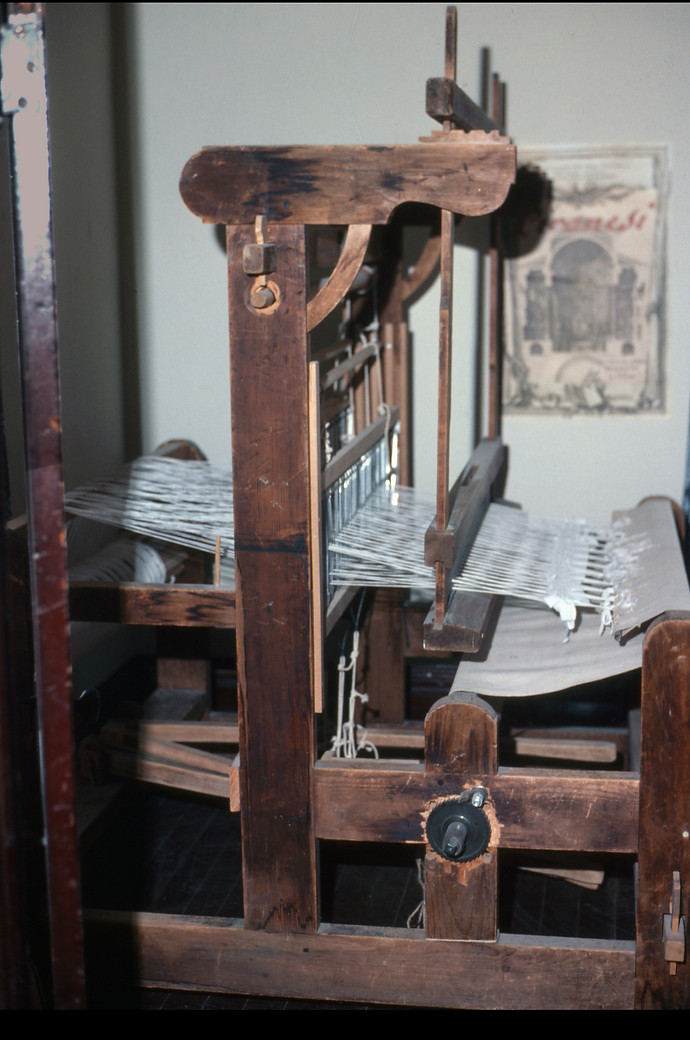ArtISt's BEGINNINGS
1950's THRU EARLY 1970's
Arts & Crafts...
During the 1950s, Wyrick’s course of study for employment as an Occupational Therapist included human anatomy (dissection), physiology, psychology, sociology, weaving (textile arts), drawing and painting for non-art majors, plus other basic courses in the liberal arts.
In her senior year at the University of Iowa, Wyrick spent some extra time at the weaving lab and, among other projects, wove draperies for the couple’s St. Paul, Minnesota apartment.
After the Wyricks later returned to Iowa City from the Twin Cities, Shirley’s parents surprised her with an antique hanging beater loom they found in a Minnesota antique barn. The loom was very wide and had been used by a farm family to weave all their household textile needs. In 1962, she wove the two tapestries pictured here on that loom. (The loom was donated to a Texas Home Museum in 1990.)

Untitled Wool Tapestries...


During her fifth college year, Wyrick was enrolled as a graduate student at the University of Iowa, but completed her year of internships at three medical facilities in the Twin Cities’ area, She then passed her registry exam as an O.T.R. and was employed at Sister Kenney Institute for Physical Medicine and Rehabilitation as a registered Occupational Therapist to the end of 1961. She worked primarily with people with physical disabilities, adapting their needed rehabilitation to interesting and absorbing activities and helping them to adapt to activities of daily living (ADLs). Looking back, all of her training was excellent preparation for becoming an artist since “adaptivity” is so closely intertwined with “creativity.”
Late 1950's

While on the Kenney staff, Wyrick read voraciously and took some night courses such as Drawing at the Minneapolis School of Art. Her ink drawing of Boots done at a night class continues to be one of her favorites.
1960's
Midsummer Nights Dream Set Design...


During the 1960’s Shirley needed a personal outlet while parenting three children and helping her husband build relationships for the UI Foundation. She became deeply immersed in volunteering for the Iowa City Community Theatre (ICCT).
Although Wyrick was never interested in being on stage, she loved doing backstage work, including Makeup, Costume and Set Design and Construction. Serving on ICCT’s Board of Directors, she helped initiate sound budgeting practices tempered with creative solutions. Because of her beliefs in harmonious relationships, a great deal of her time was also spent in reconciliation between the theatre’s volunteers.
Doing the set for A Midsummer Night’s Dream was a dream in itself. Many people helped achieve the between act’s change to the magical woodland scene. At every performance, the scene change itself, at the start of the second act, drew applause from the audience.
Branches filled with net leaves and taffeta garlands were lowered inside the frieze surrounding the stage lights, and the set itself was enhanced with paper maché blossoms, a grass green velvet throw representing the forest floor and an oversized toadstool made of foam with velvet top. Later, Wyrick also did the set for the play The Women. Featured in that play was a zebra-striped bathtub that could be rolled onto the stage area with a woman in the bath!
Teaching Macramé...




In the late 1960s, as Wyrick started to feel the need to be employed. she suggested that Kirkwood Community College offer a continuing education course in macramé for her to teach. It was a craft that was popular at the time, was easily learned and she enjoyed stimulating students to experiment. A few examples of the types of macramé she did in preparation for teaching the course are pictured here. She continued to teach the course into the early 1970s as she started to produce sculptures at the UI Sculpture Studio.
EARLY 1970's
Wyrick loved doing set design, but she began to see that theatre production designs were not long-lasting and she was beginning to want to do more permanent art. By this time, she wanted to see if she had ability in art and especially in making sculpture.
When she was invited to attend a sculpture class at the University’s Art Department, she had important decisions to make in balancing her parenting responsibilities with her classwork and art-making. But throughout her time as a student and in her career, the Wyrick children benefited from the attention she paid to encouraging them in their own creative pursuits.
Please go to Post Sculpture to read about Wyrick’s “Entry into Art”









